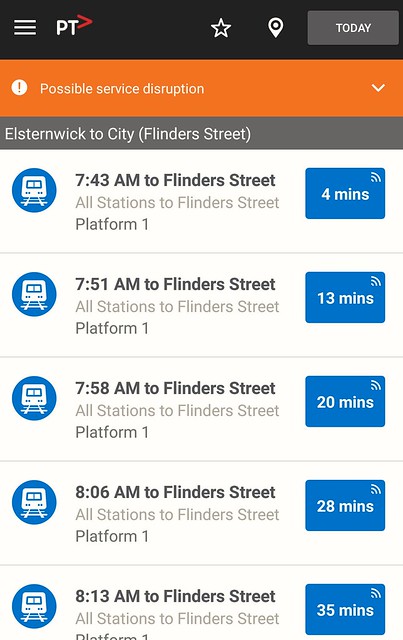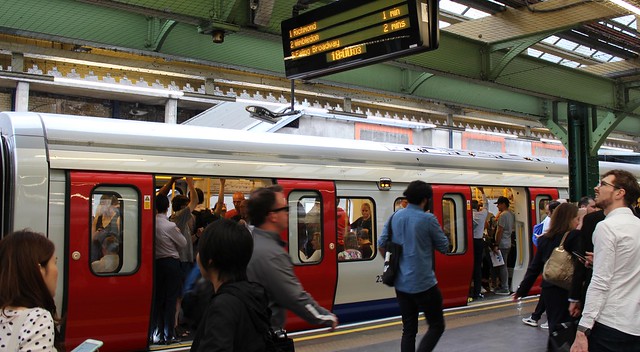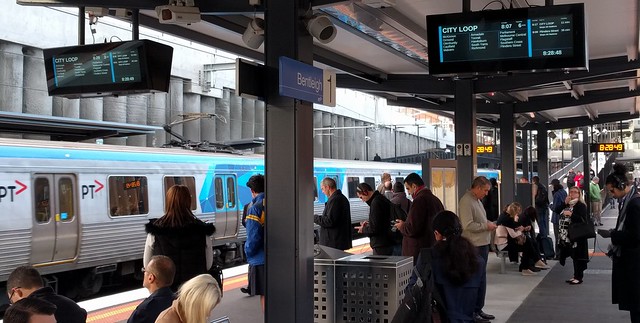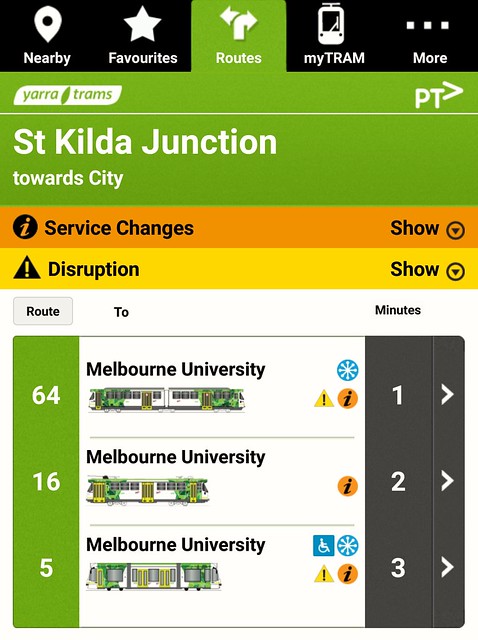One thing you notice on many of the world’s big metro systems is that people don’t check the timetable… because there is no timetable to check. Or if there is one, nobody bothers.
It’s becoming the same way around some parts of Melbourne.
Trams — most people use TramTracker displays at stops or on their phone, or they just rock up at the stop with the (not unreasonable) expectation that the next tram isn’t too far away. They want to know how many minutes until the next tram, not that it’s the 9:24.
Buses — not many individual Melbourne bus routes are very frequent. But a few are, such as the 401 and 601 University shuttles, and some of the Smartbus routes run every 6-7 minutes in peak hour.
Trains — it’s the same in peak hour on a number of train lines. If your commute is say Newport to Southern Cross, then with 9-12 trains per hour between 5am and 7pm on weekdays, you’re probably not going to bother checking a timetable.
In fact I’m told that increasingly, Myki touch-on data shows that where the trains come every 10 minutes or better, people are arriving at the station at random intervals, rather than timing their arrival at the station just before a scheduled train.
As I found recently in my non-scientific poll, increasing numbers of people use real-time information to check departure times, not static timetables… or don’t bother at all, because their service is frequent.
How do you check #MetroTrains train times? 🚇
Or are your usual trains frequent enough that you don't bother?— Daniel Bowen (@danielbowen) August 31, 2017
Maintaining headways, not timetables
What if we took it a step further? What if we said that for any service with a frequency of, say, 8 minutes or better, that the timetable no longer matters?
Some operators call this Headway Running. It recognises that maintaining a service at regular intervals is more important than having them depart at specific times.
There’s a clear benefit to passengers. Here’s an example:
This is the weekday Sandringham line timetable for Elsternwick to the City in morning peak.
7:36 7:43 7:51 7:58 8:06 8:13 8:21 8:28
Basically a train every 7-8 minutes. It’s a busy line.
So what happens when a train is cancelled? Even in the most reliable systems, it can happen. Let’s say the 7:58 goes AWOL.
7:36 7:43 7:51 —- 8:06 8:13 8:21 8:28
Everything’s fine until the 7:51. Then a big gap. Assuming each train is normally evenly loaded, you get twice as many people trying to squeeze onto the 8:06 as the others. In the real world this can result in people being left behind because there’s no space, affecting the following trains.
Longer station dwell times occur because of the crowding, as people try to get in the door, meaning the 8:06 runs late, making the problem even worse. It could take another half-hour for things to get back to normal.
What if the train operator could alter the times of the trains around the missing one, to reduce the gap?
(Some lines, Sandringham included, have infrastructure or other constraints that may or may not allow this in real life. And on some lines, differing stopping patterns make this more difficult. Assume for a moment these aren’t a problem.)
What if they were able to delay the train before by 2 minutes, and run the train afterwards 3 minutes early?
7:36 7:43 7:53 —- 8:03 8:13 8:21 8:28
The biggest gaps are now 10 minutes, which is worse than the usual 7-8, but heaps better than 15. The affected trains might have 30% more than the usual boardings, rather than double.
Most passengers wouldn’t even notice the time difference. They might notice the crowding is worse than normal, but that’s better than it being crush-loaded and/or being unable to board.
Remove the padding
There’s another benefit. Current timetables have had padding added to try and ensure punctual departures. On my line, the Frankston line, in 1997 the running time from Frankston to the City (via the Loop) was 70 minutes. It’s now 78 minutes (with only 1 minute added due to an extra station; Southland to open soon). Glenhuntly to Caulfield is now consistently timed at 5 minutes; in 1997 it was 3-4. Hawksburn to South Yarra now allows 3-4 minutes; it used to be 2-3.
With frequent service, as long as you have enough trains/trams/buses, you can unshackle them from having to wait for a specific departure time, and run them as fast as you can, as long as the frequency can be maintained. Hold them back a bit if one gets too far ahead of the next one, but otherwise, don’t wait for minutes everyday for the timetable to catch up.
South Yarra. Arrived 8:58:15. Scheduled departure 9:02:00. With this much padding, amazed trains are ever late. #MetroTrains pic.twitter.com/EXI3xVtNEJ
— Daniel Bowen (@danielbowen) August 31, 2017
Tweak the timetable at quiet times
Another benefit could be that timetables could be altered to reduce frequency when the capacity doesn’t demand it, such as between Christmas and mid-January.
Demand reduces markedly during this time, but the strategy currently employed to reduce service is a blunt instrument — on the trains at least, in years when they do it. Some services are simply dropped out of the timetable, leaving some huge, uneven gaps in the service.
(The trams actually seem to get this right, with more nuanced reductions, for instance frequency might drop from 5 minutes to 6 minutes, which is fine, provided the capacity is sufficient.)
Could we have headway running on frequent services?
The operating contracts in Melbourne mean the operator gets penalised for the cancelled train. If the other trains run late or early, they get penalised for that too.
There’s a strong argument for giving them the flexibility to alter services to minimise gaps between them — particularly when the service is very frequent, but even for less frequent services.
At some locations where very frequent services run, it’s a no-brainer. For instance St Kilda Road trams heading towards the City, where there can be a tram every minute or two, but sometimes longer gaps appear which cause overcrowding.
On the trains, this type of thing can be difficult because lines share tracks in the central area, so delaying one train can affect another.
The plan is over time for them to be separated out — hence the metro tunnel project. Eventually more lines will be independent. When that happens, you could do as other metro systems do, and feed more trains into the system, filling up capacity, maintaining a service every few minutes without worrying that a particular train arrives at 8:03 exactly.
Does it let operators off the hook?
Operators under these conditions would be off the hook for meeting specific times, but face other challenges in keeping an even frequency running. It may be quite difficult to shift drivers and vehicles around by a few minutes if they are coming from or going to other runs, or are due for a break.
And you’d still penalise operators for a cancelled services. The change would be that you wouldn’t penalise them for punctuality if (according to an agreed criteria) alterations are made to minimise gaps between services.
The point is, there are many cases where this would be better for passengers, so it would be good if it was an option on some routes.
The new contracts haven’t been published yet, but as I understand it, they will miss this change, despite increasing numbers of frequent services across the city. A shame.
Maybe next time?
Update 9am: Sorry to add this addendum, but there’s probably actually two questions here:
1. Should operators run to timetables, but have punctuality penalties waived if they shift things around to reduce gaps when cancellations occur? Cancellation penalties would still apply. Arguably this could apply at times/on services of lower frequency.
2. Should they get rid of (public) timetables altogether and run to headways permanently? This is a high frequency thing. What threshold would people find acceptable?
Thoughts?





21 replies on “If services are frequent enough, should timetables be more flexible?”
I agree, when I have used the underground in other countries, and it is quite a few, I never bothered with timetables. I never had timetables. I just showed up knowing that there would be a train in the not to distant future.
Also, you can pop into a shop or something without having to worry that you will miss your train.
Daniel, trains would need to run every 3 to 4 minutes before I would just rock up to the station, hoping for the best. I time my walk to the station in the morning so I only need to wait 2 minutes. It would be a pain to wait 8 minutes just because I didn’t read the timetable.
Having traveled on London underground, it’s great only having to wait a couple of minutes.
I think the priority should be to increase after hours trains and weekend trains to 10 minute frequency, rather than 15 or 20 mins on Sandy line now
It’s a great idea, but the current network and mode of operations makes it nearly impossible. Lines are currently intertwined and have inbuilt timetable, rolling stock and infrastructure (track points/crossovers) dependencies. They would need to untangle the lines and run them separately for Headway Running to be possible. I would hope they have a plan to do this anyway, since line separation opens up the best practice possibilities of high frequency running, and automation.
Yes! Headways (i.e. waiting times) are the only thing that matters to travellers. If the services ran often enough, it wouldn’t matter whether they were keeping to a timetable and it would be impossible for a service to arrive ‘late’. I think about this with my regular bus route all the time. The buses are so infrequent that when one is late or simply vanishes, it is really obvious and quite a pain, resulting in 40-50 minutes of out-of-vehicle waiting time. If they were running every 5-10 minutes, a delay or cancelled bus would just be the equivalent of taking the next bus – a 5-10 minute wait. It would still be possible for a service’s travel time from A to B to be longer than desired, but it wouldn’t be a ridiculous departure delay.
We shouldn’t be seeing tweets about “delays while we recover the timetable”; screw the time table. Just get the services running as fast as you can, to move the people as fast as possible. And (as an example) if a train dawdles into Ringwood late at night and the next Lilydale or Belgrave train has been cancelled for some reason – send the bloody Ringwood train to Lilydale or Belgrave! Don’t park it and leave people on the platform for another 30 minutes for the sake of the timetable!
If conventions and habits prevent sensible running, change the conventions and habits. Don’t use them as excuses for failing to deliver a decent service.
I’m with Roger, and strongly agree that trains would need to run at no more than 5 minute intervals before I’d forget about the timetable.
I wouldn’t need rely on a timetable if services were frequent AND regularly spaced. As an example of a frequent but irregular spacing, on weekdays in the evening peak hour, there are 8 train services going from Hawthorn to Richmond stations but they arrive in 13 and 2 minute intervals (16:59, 17:01, 14, 16, 28, 30, 44, 57, 59). Naturally, one plans to arrive at the quarter hour.
One night I was travelling home from Parliament station. The 23:07 Glen Waverley train had been altered to run direct from Flinders St (doh!). I decided to catch the 23:09 Pakenham to Richmond, and maybe if I was lucky they would hold the Glen Waverley at Richmond for a couple minutes to let passengers interchange.
Nope.
All well and good in a reasonable network that is run for the benefit of the patrons…not for the profit that can be squeezed out of every last facet of operations and sent back to MTR.
MTM couldn’t be trusted to operate a network without a timetable, and penalties for missing stations etc. it will be interesting to see how they adapt come November (new franchise agreement kicks in)
I check an app when waiting for a tram, the main reason being because I can. It won’t normally change anything. I will still wait for the tram. When the service is less frequent than 12 minutes, I do check in advance. Translating this headway running to my workplace, I cannot see it working when everything is timed down to the minute to extract maximum staff productivity, including the start time for staff and the hours and minutes worked. I would imagine it would similar for train drivers, so it would mean massive change behind the scenes.
Singapore trains doesn’t publish timetables, though I’m pretty sure they have an internal timetable that is published. Cancellations and late running still result in heavy fines towards operators.
Come to think of it, only some bus routes have published timetables. These are one of the not so frequent routes.
I think there’s two different things here…. Timetabled services and how real time services are shown. The timetable is irrelevant if the real time services are predictable or frequent. But that doesn’t mean we shouldn’t show predicted times. I really struggle with not being shown a time for services beyond 5-10 minutes from now.
If I’m getting ready for work or to go out somewhere and need to know when a service is half an hour from now, I shouldn’t have to sit there and do a math equation to figure out what time that service 27 minutes from now arrives. PTV currently seems to switch between ‘minutes to go’ and ‘timetabled service at about 40 minutes. This is out of whack.
I feel like there’s a balance to be had. Somewhere in the 10 minute range… if there aren’t services inside that then the predicted time or the timetable becomes more important as it aids planning.
It’s one of those areas where regular users needs conflict directly with users who are doing things out of the ordinary.
I think this is feasible for trams and some buses, but we are a way off being able to do it on most of the train network.
A better comparison than the London Underground might be the commuter heavy rail coming out of Waterloo. Trains are very frequent (every couple of minutes) to key stations, but stick to their timetables due to mess of tracks and crossovers in the area.
10 minutes is not frequent enough for widely available public timetables not to be useful as it is still a significant wait for most people. They are in fact very useful because they are so easy to remember as they are, when properly done, have passenger relevance for just the single digit number of minutes and the boundaries of 10 minute operation.
When trains run late in peak, the crowding issues cause most delays to the inner-most passengers because passengers at outer stations can still get on their more crowded intended train but when the carriages fill up, inner station passengers cannot get on at all and have to wait. Having trains run the inner part of the line, rather than none of it, should thus be a priority. There are also some line which are more heavily loaded in the counter-peak department (at least in the inner-sections), so this also has to be taken into account when calculating whether or not to cancel counter-peak trains. The Belgrave, Lilydale and Alamein lines are the biggest case of this but the Pakenham/Cranbourne line is not without a relatively strong counter-peak.
Removing the padding in the timetable would be good. Another way to speed up some of the trains is to remove the level crossing with trams. This would noticeable reduce travel time between Glenhuntly and Caulfield (or further-out-Caulfield for express trains which are impacted more severely), Heyington and Kooyong and Riversdale and Willison (or Riversdale-Hartwell if Willison is closed for being too close to Riversdale).
The spacing of stoppers on the Belgrave, Lilydale, Alamein and Glen Waverley lines is effected by several factors. Firstly, there are 4 lines and a few intermediate termini and so the timetabling is complicated partly to get them all their services. Secondly, the single track sections at the end of 3 of the 4 lines reduce flexibility and ability to space trains, as do the single terminating platforms at intermediate termini. Thirdly, stopping patterns (particularly in the direction (counter-peak/counter extended shoulder-peak) that does not get the third track) also effect the ability to run services evenly spaced both from a track capacity perspective and to allow changes of trains that reduce stopping for people changing between stopping patterns.
I still think it is important to publish timetables. If you are planning on making a connection to a long distance or interstate train at Southern Cross, such as the 1:05 Warrnambool train, then you need to check a timetable to see which metro service will get you there with time to spare. Only knowing the frequency won’t help you out there. If I am able to check a timetable, I can see which service will arrive in the city at around 12:40, and catch that service.
There seems to be little point checking timetables, when they seem to be a bit of a fiction, anyway.
I arrived at a Melbourne station 11 minutes before the train I intended to catch, and the previous one was there, and I got on it, and noticed that the next train was in 22 minutes, so the timetabled train I planned to catch had apparently disappeared.
Melbourne’s train system is ridiculous with that stupid loop. On the Frankston line, trains are often announced as being “to Flinders Street direct”, or “via loop”, which is clear enough. But then you have the trains which are “all stops to Flinders Street”. So, which is that ? Are they deliberately trying to annoy or confuse people ? And when the train stops at Richmond, it’s “your next train to the city is on platform 3”. So where is it going ? Am I going to be surprised ?
Flinders Street station is a bit of a joke. No signs at all in their stupid tunnel, either electronic or static. Which is the next train to Southern Cross ?
@enno 100% agree with you
10 minutes would be my threshold. I think knowing real time running is important, but not sure we could do away with timetables completely. Luckily my train to Geelong was a couple of minutes late this morning, or else I would’ve missed it (train from West Footscray to Sunshine was 6 minutes late, completely eating into the 6 minutes to change platforms). And coincidentally 6 minutes was the gap to the next train at West Footscray – so effectively the 8.50 didn’t run! Not sure whether the previous service was running late or not. And there was a Metro announcement that they were running a good service! I always find that a bit humourous, because I’ll be the one to tell Metro whether they’re running a good service or not!
[…] The pace of the Overground train seemed slower than the Underground – this was part of what prompted my blog post about the disadvantages of sticking strictly to a timetable. […]
It’s certainly an interesting idea, but at the rate things are going, we’ll be using timetables for the rail network at the very least. The Metro Tunnel Business Case, which is the most recent document that details the government’s plans for service levels show, alarmingly, 20 mins or worse service past West Footscray in 2026, and as such it seems unlikely that frequent rail services will be rolled out anywhere.
The South and Eastern suburbs (as usual) fare far better, but it is unlikely that headway running will be practical given the interactions and connections across the network (can’t hold a train that is due to form another service, especially if that service is only every 20 mins). And headway running becomes convenient when headways start dropping below 6-7 mins.
For trams and very frequent bus services, however, headway running is a fairly reasonable idea. In fact, many tram stop timetables have been replaced by frequency guides for periods of the day, although they frequencies are often not high enough to justify this, in my opinion. Where services are sufficiently frequent, headway running can be used to reduce the effect of congestion and bunching commonplace with shared ROW services, and the greater flexibility in the network (short shunting, buses running express etc.) works well with the headway model.
I know the buses in London don’t have a timetable. They just publish they run every 3-5 minutes. So if we were to change things here it wouldn’t be first in the world.
[…] adding more of the same scheduled services. Daniel Bowen considers benefits of running trains continuously without a timetable so that time spent waiting for a train is minimised, but the travel time remains the same. […]